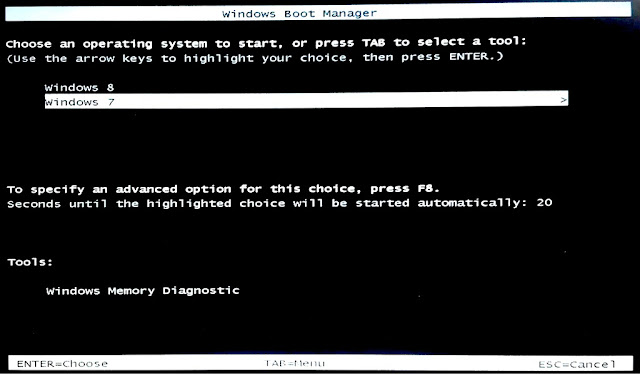Windows Boot Manager (BOOTMGR) is a small piece of software, called a boot manager, that's loaded from the volume boot code, which is part of the volume boot record.
BOOTMGR helps your Windows 10, Windows 8, Windows 7, or Windows Vistaoperating system start.
- A “clean boot” starts Windows with a minimal set of drivers and startup programs, so that you can determine whether a background program is interfering with your game or program. If you want to free up drive space on your computer before you perform a clean boot, see Free up drive space in Windows 10 or Tips to free up drive space on your PC in Windows 8.1 or Windows 7.
- Download software in the Boot Manager/Disk category - Page 4. A tool to convert Windows Vista / 7 Setup DVD to your A-DATA USB Storage in order to leave those u. May 5th 2011, 17:41 GMT.
BOOTMGR eventually executes winload.exe, the system loader used to continue the Windows boot process.

When you are trying to boot your system, you can look for various easy to use and helpful software in Google by typing boot manager and multi-boot loaders, graphical boot manager, dual boot system, multiboot os software, osl2000 boot manager, multiboot windows, dual boot windows 7 and windows 8 and multiboot windows. Download boot-loader for free. System Utilities downloads - Bootloader by Boot-Loader and many more programs are available for instant and free download. During the call, I had to delete the Windows Boot Manager that figured in the sequence, and which was not working. And then to add it again. And no, it does not download only what it needs through the download manager, it downloads a lot of stuff for applications I even don't have installed.
Where Is Windows Boot Manager (BOOTMGR) Located?
Configuration data required for BOOTMGR can be found in the Boot Configuration Data (BCD) store, a registry-like database that replaced the boot.ini file used in older versions of Windows like Windows XP.
The BOOTMGR file itself is both read-only and hidden, and is located in the root directory of the partition marked as Active in Disk Management. On most Windows computers, this partition is labeled as System Reserved and doesn't have a drive letter.
If you don't have a System Reserved partition, BOOTMGR is probably located on your primary drive, which is usually C:.
Can You Disable Windows Boot Manager?
Why would you want to disable or turn off the Windows Boot Manager? Simply put, it can unnecessarily slow down the boot process as it waits to ask you which operating system to boot. If you don't need to choose which operating system to boot to, maybe because you always like to start the same one, then you can avoid it by pre-selecting the one you always want to start.
However, you can't actually remove the Windows Boot Manager. What you can do is reduce the time that it waits on the screen for you to answer which operating system you want to start. You can do this by pre-choosing the operating system and then lowering the timeout time, basically skipping the Windows Boot Manager altogether.
This is accomplished through the System Configuration (msconfig.exe) tool. Here's how to do this:
Be careful when using the System Configuration tool — you might make unnecessary changes that can just cause more confusion in the future.
Open Administrative Tools, which is accessible through the System and Security link in Control Panel.
If you don't see the System and Security link on the first page of Control Panel, select Administrative Tools instead.
Another option for opening System Configuration is to use its command line command. Open the Run dialog box (WIN+R) or Command Prompt and then enter the msconfig.execommand.
Choose the operating system you want to always boot to. Remember that you can always change this again later if you decide to boot to a different one.
Adjust the Timeout time to the lowest possible time, in seconds, which is probably 3.
A System Configuration screen might pop up after saving these changes, to inform you that you might need to restart your computer. It's safe to choose Exit without restart — you'll see the effect of making this change the next time you restart.
Additional Information on BOOTMGR
A common startup error in Windows is the BOOTMGR Is Missing error.
Windows 7 Boot Manager File Download
BOOTMGR, together with winload.exe, replaces the functions performed by NTLDR in older versions of Windows, like Windows XP. Also new is the Windows resume loader, winresume.exe.
When at least one Windows operating system is installed and selected in a multi-boot scenario, the Windows Boot Manager is loaded and reads and applies the specific parameters that apply to the operating system installed to that particular partition.
Windows 7 Boot Software Download
If the Legacy option is chosen, the Windows Boot Manager starts NTLDR and continues through the process like it would when booting any version of Windows that uses NTLDR, like Windows XP. If there's more than one installation of Windows that's pre-Vista, another boot menu is given (one that's generated from the contents of the boot.ini file) so that you can select one of those operating systems.
The Boot Configuration Data store is more secure than the boot options found in previous versions of Windows because it lets users in the Administrators group lock down the BCD store and give out certain rights to other users to determine which ones can manage boot options.
Windows 7 Boot Manager Repair Download
As long as you're in the Administrators group, you can edit the boot options in Windows Vista and newer versions of Windows using the BCDEdit.exe tool included in those versions of Windows. If you're using an older version of Windows, the Bootcfg and NvrBoot tools are used instead.